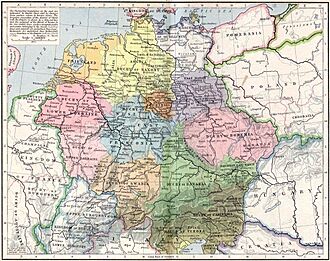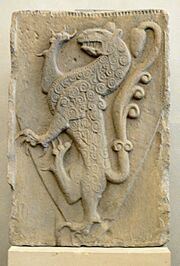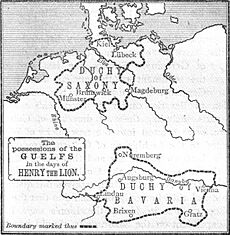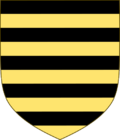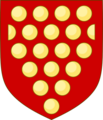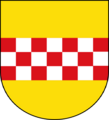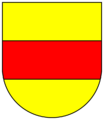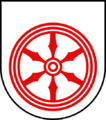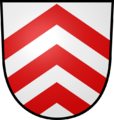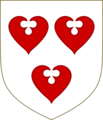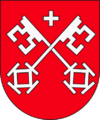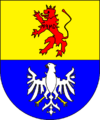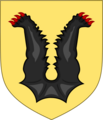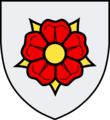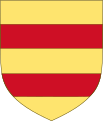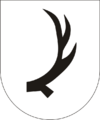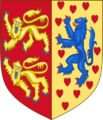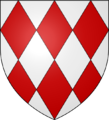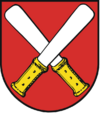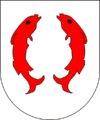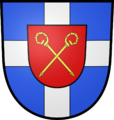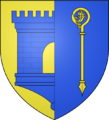Duchy of Saxony facts for kids
Quick facts for kids
Duchy of Saxony
(and the Palatinate of Saxony) |
|||||||||||||||||||||||||||||||||||||
|---|---|---|---|---|---|---|---|---|---|---|---|---|---|---|---|---|---|---|---|---|---|---|---|---|---|---|---|---|---|---|---|---|---|---|---|---|---|
| 804–1296 | |||||||||||||||||||||||||||||||||||||
|
Left: Arms of Ascanians (from around 1000), who ruled the Duchy of Saxony last
Right: Coat of arms of the Palatinate of Saxony (institutied in the southern part of the duchy) |
|||||||||||||||||||||||||||||||||||||
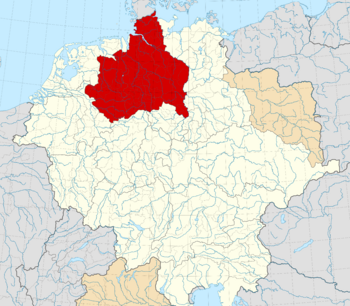
Saxony around 1000 CE, within the German Kingdom
|
|||||||||||||||||||||||||||||||||||||
| Status |
|
||||||||||||||||||||||||||||||||||||
| Capital | None (ducal) Allstedt (seat of the Palatinate) |
||||||||||||||||||||||||||||||||||||
| Official languages | Latin | ||||||||||||||||||||||||||||||||||||
| Common languages | Old Saxon Middle Low German |
||||||||||||||||||||||||||||||||||||
| Religion | Roman Catholic (official) Germanic paganism |
||||||||||||||||||||||||||||||||||||
| Government | Feudal Duchy | ||||||||||||||||||||||||||||||||||||
| Historical era | Middle Ages | ||||||||||||||||||||||||||||||||||||
|
• Conquest of Charlemagne
|
804 | ||||||||||||||||||||||||||||||||||||
|
• Welf ascendancy
|
1137 | ||||||||||||||||||||||||||||||||||||
|
• Expanded by conquest
|
1142 | ||||||||||||||||||||||||||||||||||||
|
• Welfs deposed, Ascanians enfeoffed with severely belittled duchy
|
1180 | ||||||||||||||||||||||||||||||||||||
|
• John I and Albert II co-rulers
|
1260 | ||||||||||||||||||||||||||||||||||||
|
• Competences divided
|
1269, 1272 and 1282 | ||||||||||||||||||||||||||||||||||||
|
• Definite partition into Saxe-Lauenburg and Saxe-Wittenberg
|
1296 | ||||||||||||||||||||||||||||||||||||
|
• Wittenberg Ascanian line extinct; reunification failed
|
1422 |
||||||||||||||||||||||||||||||||||||
|
|||||||||||||||||||||||||||||||||||||
| Today part of | Germany | ||||||||||||||||||||||||||||||||||||
The Duchy of Saxony was an important territory in Germany during the Middle Ages. It was originally the home of the Saxons, a powerful group of people. In the late Early Middle Ages, a famous ruler named Charlemagne conquered the Saxons during the Saxon Wars (772-804). He made their land part of his large Carolingian Empire.
After Charlemagne's empire split in 843, Saxony became one of the main "stem duchies" of East Francia (the eastern part of the empire). A "duchy" is a territory ruled by a "duke." In 919, the Saxon Duke Henry the Fowler was even chosen to be the German king!
Later, in 1180, a powerful duke named Henry the Lion from the House of Welf family lost his title. The ducal title then went to the House of Ascania family. Many parts of Saxony also broke away to form their own territories. For example, the Principality of Anhalt formed in 1218, and the Duchy of Brunswick-Lüneburg (ruled by the Welfs) formed in 1235.
Finally, in 1296, the remaining lands of the Duchy of Saxony were divided into two smaller duchies: Saxe-Lauenburg and Saxe-Wittenberg. The rulers of Saxe-Wittenberg later gained the important title of "Electors of Saxony" in 1356. This meant they could help choose the Holy Roman Emperor.
Contents
Where Was the Duchy of Saxony?
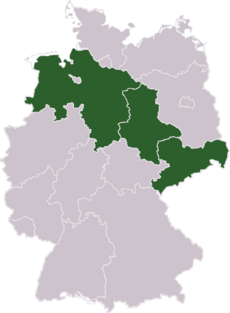
The original Saxon duchy covered a large part of what is now Northern Germany. This included areas like Lower Saxony and Saxony-Anhalt. It also stretched to the Elbe and Saale rivers in the east. Even the city-states of Bremen and Hamburg were part of it.
The western part of North Rhine-Westphalia (called Westphalia) and the Holstein region in Schleswig-Holstein were also included. In the late 1100s, Duke Henry the Lion even took over the nearby area of Mecklenburg.
The Saxons were a very strong group of people. Their name became famous and was used for many different areas over time. This includes Old Saxony, Upper Saxony, and the Electorate of Saxony. Today, the German state called the Free State of Saxony uses the name. But its land was not part of the original medieval duchy.
A Look Back: History of Saxony
The Older Duchy: Saxon Beginnings
The Saxons originally came from a place called Britannia. They settled near the coast in the Elbe-Weser Triangle. They were called by the Frankish rulers to help conquer the Thuringian kingdom. This is a bit like the story of how Saxon tribes from this region invaded Britain after the Romans left.
In 743, the Frankish rulers, led by Carloman and his brother Pepin the Short, fought against the Saxons. Pepin, who became the Frankish king in 750, continued to invade Saxony. He managed to control some western Saxon tribes by 758.
In 772, Charlemagne, Pepin's son, began his final conquest of the Saxon lands. This was a long and difficult fight. The Saxon lands were divided into different tribes, like Westphalian, Eastphalian, and Angrian. Charlemagne had to make separate peace deals with each tribe. But these deals were often broken by other Saxon groups.
The Saxons even destroyed a Frankish fort called Eresburg. Their leader, Widukind, refused to attend a meeting in Paderborn in 777. He then led several uprisings against the Franks. Charlemagne got his revenge in 782 at the Massacre of Verden. Widukind finally promised loyalty in 785 and was baptized. But Saxon uprisings continued until 804. By then, the entire duchy was part of Charlemagne's empire.
After the conquest, Saxony was ruled by officials appointed by Charlemagne. One of them was Wala of Corbie, Charlemagne's cousin. In 811, Wala signed a treaty with the King of Denmark. This treaty set the northern border of the empire along the Eider River. Some of the dukes appointed were Saxons themselves. For example, Count Ekbert, who was married to Saint Ida of Herzfeld, a relative of Charlemagne.
The Younger Duchy: Rise of the Ottonians
Ida of Herzfeld might have been an ancestor of the Saxon count Liudolf. He died in 866. Liudolf married Oda of Billung and ruled a large area in Eastphalia. He and Bishop Altfrid founded Gandersheim Abbey in 852. Liudolf's family, the Ottonian dynasty, became very important. They produced dukes, kings, and even emperors.
The Saxons, who had been conquered just a few decades earlier, became one of the most important groups in East Francia. Liudolf's son, Otto the Illustrious, became a powerful duke. His position was so strong that he married Hedwiga, the daughter of the mighty Duke Henry of Franconia. Otto was able to unite the Saxon duchy under his rule.
In 911, the Carolingian family in East Francia ended when King Louis the Child died. The dukes of Saxony, Swabia, and Bavaria then met to choose a new king. They chose Conrad I of Franconia. One year later, Otto's son, Henry the Fowler, became Duke of Saxony.
In 919, Henry the Fowler was chosen as King of East Francia. He was able to bring the other duchies together into a strong kingdom. This was important for fighting off attacks from Hungarian forces. Around 928-929, Saxon troops took over large areas in the east. These lands were settled by Polabian Slavs. Henry's campaigns to Brandenburg and Meissen marked the beginning of German expansion to the east.
The Billung Family Takes Over
- 936: After Henry the Fowler died, his son Otto I became king. Otto appointed Hermann Billung as a "Markgraf" (a military leader in a border region). Hermann's job was to control the Slavic people beyond the Elbe River.
- 961: Otto I went to Italy. Hermann Billung became the main administrator of Saxony. He was basically the duke, even if he didn't have the official title yet.
- 973: Hermann Billung died. Soon after, Otto I also died. Otto II became Emperor. He made Hermann's son, Bernhard I Billung, the first official duke of Saxony from the Billung family.
- 983: There were uprisings by the Danes and Slavs in northern Saxony.
- 1011: Duke Bernhard I Billung died. His son, Bernhard II, became duke.
- 1042: Ordulf Billung, Bernhard II's son, married Wulfhild. She was the half-sister of King Magnus I of Denmark and Norway. Danes and Saxons fought together against the Wends.
- 1059: Ordulf Billung became Duke after his father's death.
- 1072: Magnus Billung became Duke.
- 1106: Duke Magnus died without children. This ended the Billung family's rule. Their lands became part of the Welf and Ascanian territories. Lothar of Supplinburg became Duke of Saxony.
- 1112: Otto of Ballenstedt was made Duke by Emperor Henry V, Holy Roman Emperor.
- 1115: Lothar of Supplinburg won a battle against King Henry V at Welfesholz.
- 1125: Lothar of Supplinburg was chosen as German King and crowned Emperor.
- 1137: Lothar died. Henry X "the Proud" from the Welf family was supposed to become the next Duke of Saxony. But he was already Duke of Bavaria, and other rulers didn't want him to be too powerful.
- 1138: Henry X lost the election for King of the Germans. He refused to give up his two duchies (Bavaria and Saxony). So, he lost all his titles. The Duchy of Saxony was given to Albert the Bear from the Ascanian family.
- 1139: Henry X still owned a lot of land in Saxony because of his marriage. He fought hard against Albert's attempts to take over. Henry X died unexpectedly while preparing to attack Bavaria.
- 1141: Albert the Bear gave up the Duchy of Saxony. The title was then given to Henry X's young son, Henry the Lion.
Henry the Lion: A Powerful Duke
In 1142, King Conrad III of Germany officially made Henry the Lion (from the Welf family) the Duke of Saxony. Henry slowly expanded his rule over northeastern Germany. He led crusades (holy wars) against the pagan Wends. During his time as duke, Henry strongly supported the growth of cities like Brunswick, Lüneburg, and Lübeck. This helped the Welf family move their power from southern Germany to the north.
In 1152, Henry helped his cousin Frederick III of Swabia become King of Germany (Frederick I Barbarossa). Henry likely did this because Barbarossa promised to give him back the Duchy of Bavaria. With Bavaria and Saxony, Henry's lands covered more than two-thirds of Germany. This made him one of the most powerful rulers in central Europe. But it also made him a threat to other German princes and even to Barbarossa himself.
Henry wanted to expand his rule even more. He tried to claim titles from smaller noble families who didn't have heirs. This made many Saxon nobles and other German princes angry, especially Albert the Bear, his father's old enemy. In 1166, while Barbarossa was in Italy, a group of German nobles declared war on Henry. The war continued until 1170, even though the Emperor tried to make peace. Henry's power remained strong because Barbarossa supported him.
In 1168, Henry married Matilda Plantagenêt. She was the daughter of Henry II of England and Eleanor of Aquitaine, and the sister of Richard Lionheart.
In the years that followed, Henry and Barbarossa grew apart. Henry stopped supporting the Emperor's campaigns in Italy, which were not going well. Instead, he focused on his own lands. In 1175, Barbarossa asked for Henry's help against the Lombard League. Henry is said to have refused, even when Barbarossa knelt before him. This story was written down years later, and different sources tell it differently. But without Henry's help, the Battle of Legnano was a big defeat for the Emperor.
When most of the princes returned from Italy, Henry's refusal was used to weaken his position. It's not clear if Barbarossa started Henry's downfall or if the other princes did.
Between 1175 and 1181, Henry faced many accusations. He was accused of dishonoring the empire, breaking the peace, and treason. If he had gone to the court meetings, he would have admitted the charges were true. So, he refused to go. In 1181, he was stripped of all his titles. Henry didn't give up easily. In 1180, he attacked the city of Goslar, which he had wanted for years. During the war that followed, Henry's way of ruling and treating his vassals (nobles who owed him loyalty) caused his power to quickly fall apart.
In 1182, Henry the Lion went into exile. He joined the court of his father-in-law, Henry II of England. After his wife died and the Emperor died during the Third Crusade, Henry returned to Brunswick in 1189. He tried to get his lost lands back. But after some difficulties, Henry made peace with Barbarossa's son, King Henry VI, Holy Roman Emperor.
The old Duchy of Saxony was then divided into many smaller territories by Barbarossa. It stopped existing as one large duchy. The western part was split among several smaller counties and bishoprics. The new Duchy of Westphalia was also formed. In the east, the Ascanians, who were old rivals of the Welfs, finally got a much smaller Duchy of Saxony. This new duchy only included the easternmost parts along the Elbe river, around Lauenburg and Wittenberg. Because of this, the name "Saxony" moved from northwestern Germany to the area of the modern Free State of Saxony.
The Welf family, who had been dukes, kept their private lands. These lands were no longer part of the Duchy of Saxony after the Ascanians took over. The Welf lands became the Duchy of Brunswick-Lüneburg in 1235. This duchy continued to use the old Saxon coat of arms: a white horse on a red background. The Ascanians, for their "younger Duchy of Saxony," used their family colors: black and gold stripes with a green crown-like symbol.
The Ascanian Family Takes Over
In 1269, 1272, and 1282, the brothers John I and Albert II ruled Saxony together. They slowly divided their power in the three separate Saxon areas: Hadeln, Lauenburg, and Wittenberg. This was a step towards officially splitting the duchy.
John I stepped down in 1282, giving power to his three young sons. He died three years later. His sons and their uncle Albert II continued to rule Saxony together.
In 1288, Albert II asked King Rudolph I to give his son, Duke Rudolph I, the Palatinate of Saxony. This started a long fight with the powerful Wettin family. When the County of Brehna became part of the empire again, the king gave it to Duke Rudolph. In 1290, Albert II gained the County of Brehna, and in 1295, the County of Gommern for Saxony.
King Wenceslaus II of Bohemia convinced Albert II to vote for Adolf of Germany as the new emperor. On April 27, 1292, Albert II, with his nephews still young, cast the Saxon "electoral vote" to choose Adolf.
The last document that mentions Albert II ruling together with his nephews is from 1295. The Duchy of Saxony was officially divided into Saxe-Lauenburg and Saxe-Wittenberg before September 20, 1296. Saxe-Lauenburg was ruled by the brothers Albert III, Eric I, and John II. Saxe-Wittenberg was ruled by Albert II. Albert II became the founder of the Ascanian line of Saxe-Wittenberg.
Later, members of the Welf family (from the House of Hanover) became "prince-electors" of Hanover. They also became kings of Great Britain, Ireland, and later the United Kingdom and the Hanover.
Images for kids
See Also
- Saxony (disambiguation)
- History of Saxony





